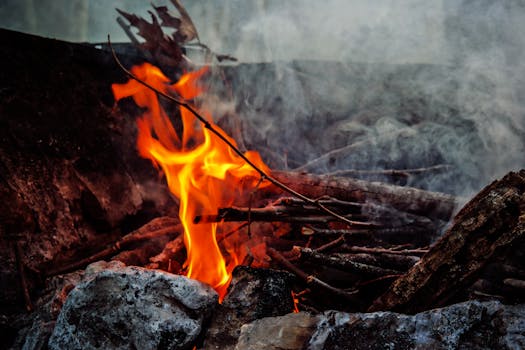
Fire is essential for survival, cooking and warmth. Usually a fire is started with thin or split wood kindling but there are many other kinds of tinder and kindling that can be used if you're in a scrape and cannot locate any small wood.
Find tinder. Kindling tends to be the material used to let larger wood really catch, while tinder is small shavings or shreds of material that will burn hot quickly and starts the kindling burning. Kindling is larger than tinder. Examples of tinder include dry grass, dry bark and down from birds. Once the tinder is burning, you can slowly add the kindling, unless you've already arranged it in a style such as a lean-to or tip over the tinder (see below for links to building the fire). However, there is a fine line between what can be used as tinder and what can be used as kindling––sometimes certain material can be used for both purposes. Some ideas for tinder (some of which might also be useful as kindling) include:
- Use lint. Pack a toilet paper roll with dryer lint. When you're ready for a fire, pile wood around the lint roll. Light the center of the cardboard roll (exterior) and it'll catch fire and burn outwards, catching on the piled wood as it burns. The beauty of this is that it's making use of items around the house and it doesn't weigh much in your pack. Also note that if you have several of these, they can serve as kindling as well as tinder.
- Use pine needles. Use pine needles or pinecones to start a fire. Select only dry needles, not green ones, as these won't take as easily. Pile onto the fire in little lots rather than everywhere or it risks smothering the flame.
- Save and dry small pieces of tree bark. Bark catches fire quickly and will maintain embers for a long time.
- Use dry debris. Use dry debris from your yard, such as twigs, leaves, and moss to start a fire. Ensure that there isn't too much soil in what you've gathered, as it can prevent fire from lighting.
- Find a substitute for kindling. Normally you'd look for dry wood, such as tree limbs, tree twigs and branches, or split wood if at an organized campsite. However, this isn't always possible, so the following ideas are presented to help you in a pinch.
- Use your favorite potato chips as a fire starter. If you have a bag of potato chips handy, they can function as a fire-starter due to the fat content of the chips. Light a chip with a lighter or a match and it will burn for approximately 3 minutes. Add the lit chip to a pile of chips on the campfire you've set up (see below for making a fire). While the chip kindling is burning, place light, dry wood on top to catch alight over the burning chips.
-
Use newspaper. Roll five dry newspapers into a tight tube, tie the tube into a knot, and light the knot on fire. The tight paper will burn slowly, allowing more time for the wood to catch fire.
- Tying the paper into a knot will prevent the layers from moving around when lit.
-
Use pine cones. Pine cones are quick to catch fire over tinder (such as pine needles). As well as being suitable kindling, they give off a great aroma.
-
Make the fire. Once you've assembled the tinder and kindling, you'll need to make a decision as to how to build the fire. There are quite a few ways to build a fire, each having its own utility dependent on where you are, the temperature and weather and the terrain, etc. Here are some articles to follow on to, which will explain how to make a fire successfully:
-
7Enjoy a night under the stars next to the warmth of your new fire. Keep the fire well stoked by adding new fuel regularly throughout the time of the fire's use.
- If the fire goes out, sometimes you can restart it simply be shifting around the coals and throwing on some more kindling to catch fire to the existing hot logs on the campfire.
- Wet wood can be dried out next to a fire; sometimes you'll have no choice.






No comments:
Post a Comment